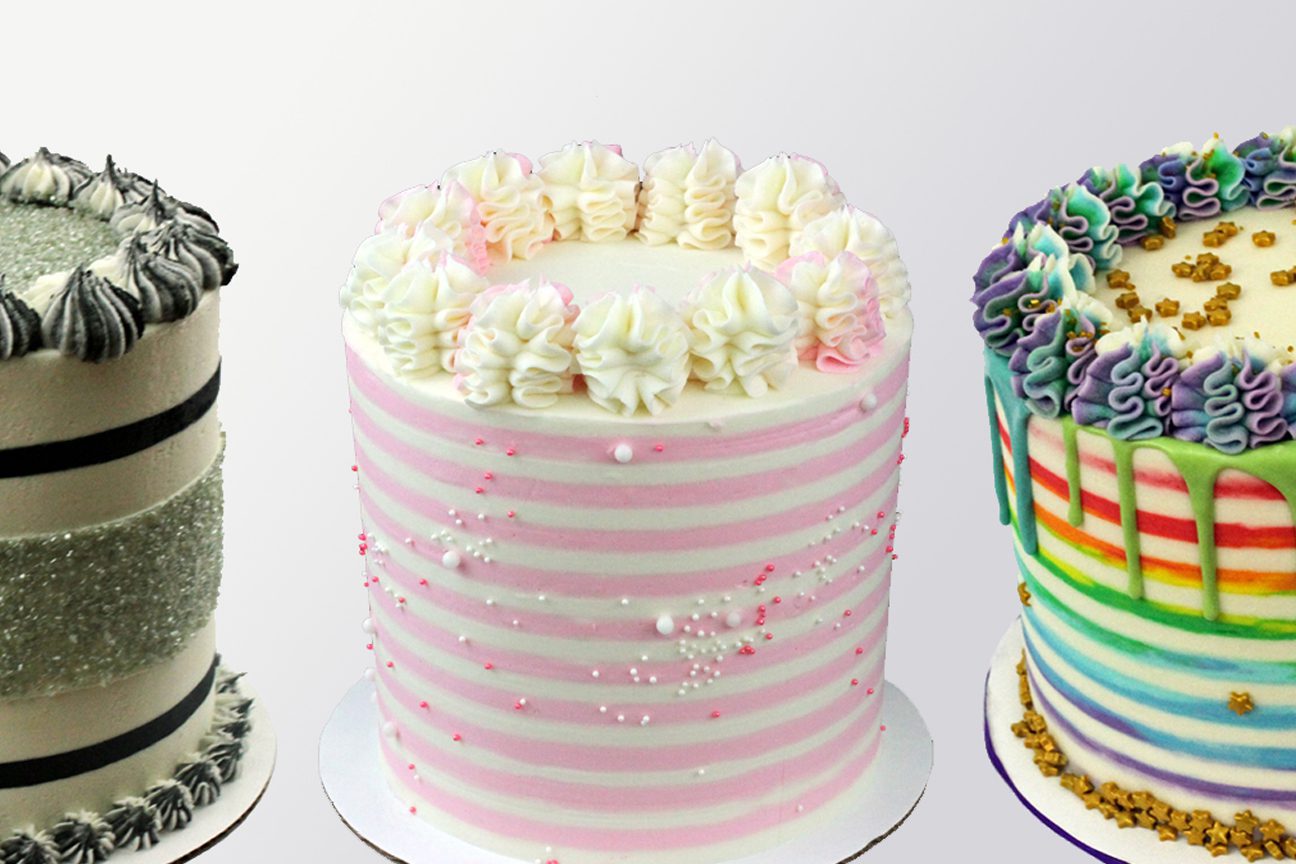
In this tutorial I’m going to share four secrets to get perfect stripes on cakes using buttercream frosting! I’ll also show you a few variations to get different styles of stripes and then do some troubleshooting to answer questions about why your stripes aren’t turning out exactly the way you want them to. If you prefer to watch a video version of this tutorial, scroll down to the bottom of the page.
The process to get perfect stripes starts long before creating the stripes. When you assemble your cake, make sure your layers are lined up evenly on top of each other to give your cake straight even sides. Don’t apply too much filling between the layers or it will bulge out when the cake gets to room temperature.

You’ll need to crumb coat your cake, which is a thin layer of frosting to trap any crumbs that come off the cake so your final layer of frosting will be crumb free. Now that your cake is ready, let’s explore the striping technique.
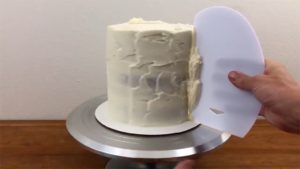
A striped cake comb looks like this. There are lots of different types: plastic, metal, or acrylic. Whatever you choose, just make sure the comb is at least as tall as your cake.
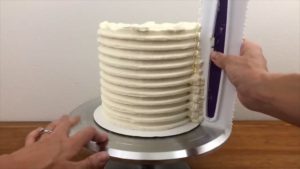
Here’s a quick diagram for how the striped cake comb works. This is a cross section of the cake with a crumb coat and then a final coat of frosting. You use your cake comb to make these nice deep grooves in the frosting and then you chill it.
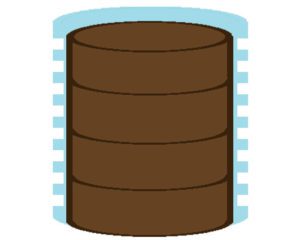
You apply another colour of frosting to fill in the grooves and that frosting will probably also spread over the original frosting on the cake, which is fine.

Then you use a frosting scraper to scrape off the extra frosting, a few layers of it, leaving these beautifully neat stripes. Now let’s see it in real life.
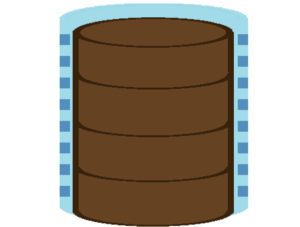
You apply another colour of frosting to fill in the grooves and then you use a frosting scraper to scrape off the extra frosting, a few layers of it, leaving these beautifully neat stripes. Now let’s see it in real life.

When your crumb coat has set, apply the first colour of frosting to your cake. I’m using my 4 Minute Buttercream which I love because it’s easy to make, delicious, and sets when it’s chilled, which makes this technique successful. If it’s too thick to be able to spread it easily over your cake, add some cream or milk to thin it out a bit.
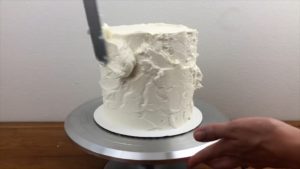
The first secret to perfect stripes is to make sure the frosting is at least as thick as your cake comb grooves all around the cake. This might seem like a lot of frosting but you’re going to scrape a lot of it off by the time the cake is finished and having this much frosting ensures solid neat stripes. Get your top and sides fairly smooth (they don’t have to be perfect yet) and don’t worry about frosting sticking up over the sides of the cake yet.
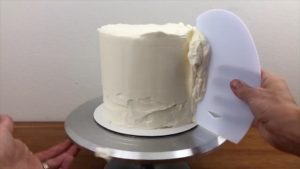
The second secret to perfect stripes is to make sure the sides of the cake are straight and even. When you look at the cake from every angle you want the sides to be straight, not slanting diagonally up or down because when you use the cake comb your grooves will end up being different thicknesses and the stripes in the shallower grooves will get swallowed as you smooth out your cake. I’ll show you an example of this with some troubleshooting later.

Now take your striped cake comb and place it against the side of the cake. Line it up so the base is flat on the cake board and make sure you are holding it straight up vertically against the side of the cake. Spin your

After passing the frosting comb around a few times you’ll probably have air pockets in the part sticking out, which will be the white stripes. If your frosting comb grooves are deep enough you’ll be scraping off so much frosting that the air pockets won’t matter but if you have shallow grooves, the next colour of frosting is going to get into the air pockets and leave marks on the white stripes. For perfect stripes, you can either go deep with your frosting comb grooves or you can fill in the air pockets with some extra frosting, spreading it on with an
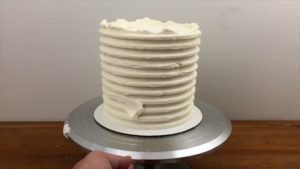
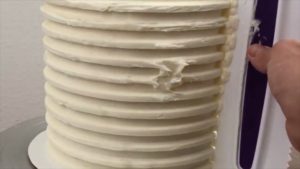
Tidy up the top edge by scraping any frosting sticking up over the top of the sides of the cake. You can see here that the top of my cake has the first parts of a groove, which would make a teeny tiny skinny part of a stripe. Because I have a thick coating of frosting on my cake I can just smooth this groove out onto the top of my cake, taking that stripe away completely so that the top stripe of my cake is a complete stripe.
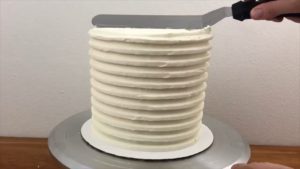
Here comes the third secret to perfect stripes. When you’re happy with the stripe grooves and the top frosting, chill your cake in the fridge for 30 minutes or in the freezer for 15 minutes while you prepare your next colour. This lets the first colour stripe set and hold its shape around the grooves before you apply the next colour. It’s also important for the top of the cake and you’ll see why in a minute.
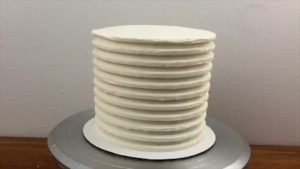
Now if you want all of your stripes to be the same colour, use an
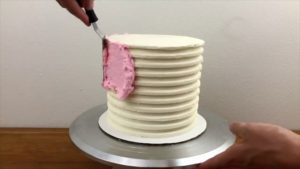
The final secret for perfect stripes is to be really patient with your frosting scraper. The first few times you go around the cake you’ll want to panic because the cake will be a messy disaster with smeared frosting and smudged blurry stripes with absolutely no resemblance to stripes.
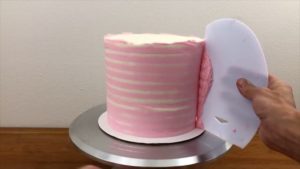
Don’t worry, just keep going. You’re wiping off the extra frosting of the second colour. A few more scrapes around the cake and you’ll expose the first colour of stripes and a few more scrapes and you’ll start seeing neater stripes. Keep going and the stripes will get more and more precise.
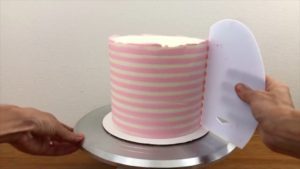
Then tidy up the top of the cake, scraping the sticking up frosting onto the top of the cake. Because you’ve chilled your cake, it’s easy to wipe the second colour of frosting off with an
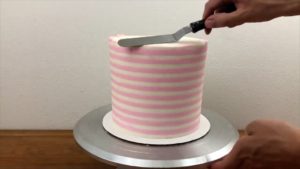
These stripes look beautiful just as they are or you can jazz the cake up with some sprinkles and frosting rosettes on top or whatever decorations you like.

Now I’m going to show you a few variations to liven up your stripes. A fun way to make your stripes even more beautiful is to use an ombre design. Crumb coat your cake and then apply all of your colours to the side in rows going up the cake. I’m using an

Smooth the frosting with a frosting scraper, filling in any gaps in the frosting by spreading on more of that colour. You can frost the top of the cake now or later, after filling in the stripe grooves, and I’ll do it later for this cake so I’m leaving just the crumb coat on top for now.
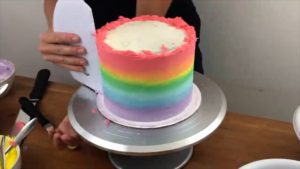
Use your striped cake comb to indent stripe grooves into the frosting. Tidy up the top edge of the cake by scraping off the sticking up frosting with an

After chilling the cake, apply another colour of frosting to the sides of the cake to fill in the stripe grooves. I’m also using white frosting for the top of the cake.

Then use your frosting scraper to smooth the sides and the top of the cake. As you scrape away layers of white buttercream you’ll reveal the rainbow or ombre stripes underneath.

The result is this pretty rainbow effect with impossibly neat stripes!
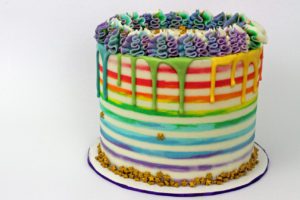
If you want the top surface of your cake to be a different colour to the stripes, apply that first. Here, when I crumb coat my cake I’m also giving the top of the cake its final coat of frosting (which is white).

Chill the cake to set the crumb coat and the frosting on top and then apply the final coat of frosting to the sides of the cake. I’m using yellow frosting for this Harry Potter cake. Smooth the frosting with a frosting scraper.
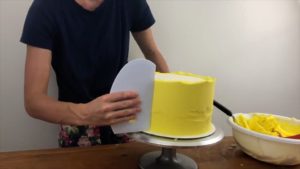
Tidy up the top edge, scraping any smudges of yellow off the top to leave the top completely white with just a ring of yellow around it, which is the top of the yellow frosting on the sides of the cake.

Use your striped cake comb to indent stripe grooves and chill the cake again, for 30 minutes in the fridge or 15 minutes in the freezer.
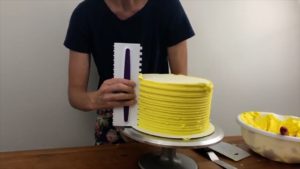
Fill the stripes in with your next colour of frosting, which you can spread onto the cake or pipe into the grooves if you prefer. More about that later!

Scrape off all of the excess frosting and here’s an example of how messy it might look after the first few scrapes.

Continue scraping several times to take off several layers of frosting, smoothing out the frosting to eventually reveal perfect stripes! I’m leaving the overhanging frosting around the tops of the sides of the cake and chilling the cake for about 30 minutes in the fridge until the frosting is firm.
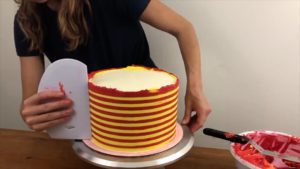
Now I’m using a sharp knife to trim around the cake, taking off the excess frosting sticking up over the sides. If you get any smudges of the side frosting onto the top frosting just use your knife to scrape it off. It’s very important the cake is cold so your knife leaves the frosting smooth.
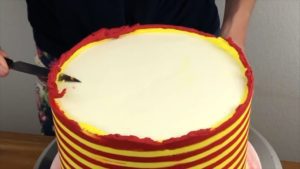
This technique leaves a neat top edge to the cake with the red and yellow frosting outlining the white center.

You can alternate the colours of your stripes by piping the frosting into the grooves made by the cake comb. I frosted this cake with pale blue frosting, used my cake comb, and now I’m piping on white and blue stripes.

You can use almost any frosting tip for this or even a piping bag with a hole cut in the end without a tip. I used a round tip (Wilton #1A) and a petal tip (Wilton #125) for this cake because it’s what I had on hand.
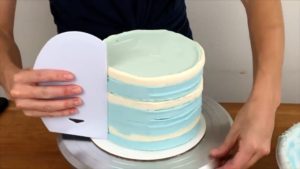
You scrape off quite a lot of frosting with this method but don’t waste it – you can mix the colours together and use the new colour to decorate another cake or you can put the blended colours into a piping bag with a star tip and pipe on these pretty frosting rosettes on top of the cake as a finishing touch.

Striped cakes are really, really easy once you get the hang of using this cake comb technique. I timed this cake from start to finish, including building the layers, crumb coat, frosting, using the comb, filling in the stripes, smoothing the frosting and piping the rosettes on top and it took me just 32 minutes!

For this cake I want one bright green stripe and the rest purple so after applying my orange frosting, using a cake comb, and chilling the cake, I’m piping on one bright green stripe into one of the stripe grooves, making sure it completely fills the groove so that there are no air pockets.

With an
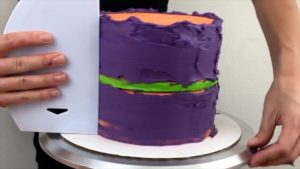
After scraping off layer after layer, I’ve exposed the perfect orange, green and purple stripes on this fun Halloween cake!
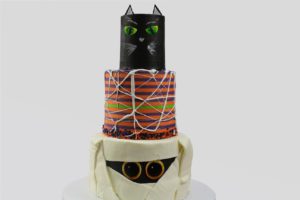
You can play around with the symmetry of the stripes because you don’t have to add a colour into every groove. If you don’t want your stripes to be regular and close together, you can space them out randomly around your cake, adding fewer stripes.

To do this, once you’ve frosted your cake and use the cake comb and chilled it, use your second colour to fill in the grooves where you want the stripes and then use the original colour of frosting to fill in the other grooves, so here I’m piping in two black stripes and then filling in the rest of the grooves with my original colour, white,
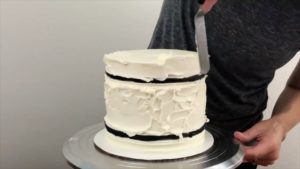
When I smooth it out, those white stripes blend with the original white frosting and the white stripes disappear so the only stripes left on my cake are the two black ones. I love this – it’s so classy!

Let’s do some troubleshooting to work out why your stripes don’t look like you want them to. Why are some of your stripes disappearing when you smooth your cake? Here’s an example of that happening: you can see that the sides of this cake aren’t perfectly straight. Although the cake comb is pressed down flat on the cake board so it’s straight, the frosting is slanting diagonally up on the cake so the grooves aren’t going in as deep at the top of the cake as they are at the bottom.
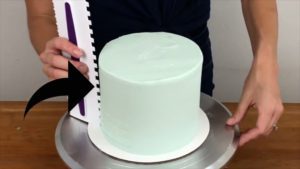
Now after filling in the grooves and smoothing the cake with a frosting scraper, the shallow groove at the top of the cake gets swallowed by the frosting smoother, scraping off the very thin layer of the stripe colour (which was white) and exposing the pale blue base frosting below.
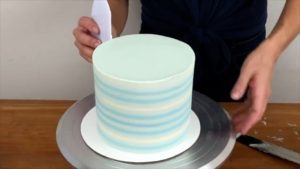
Why are there smudges of other colours in the middle of your stripes? Here’s a quick diagram explanation and then I’ll show you a real-life example. Here we have a cake with a crumb coat and a final coat of frosting. When you use your cake comb you might get indents or air pockets like the one on the third stripe down on the left.
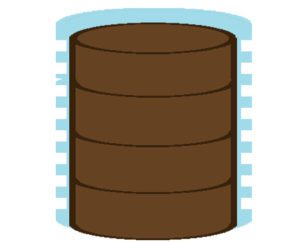
You chill your cake and apply a darker blue frosting for the stripes and that colour goes into the indent.

When you start scraping the frosting, you see the smudges of dark blue in that indent but as you keep scraping you get past the indent and you see your nice smooth stripes.
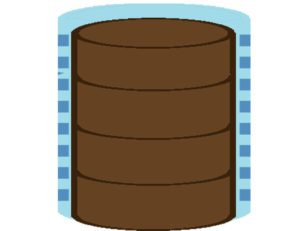
Here’s the real-life example. These thin dark blue lines on the light blue stripes are where there were indents in the base color of my frosting.
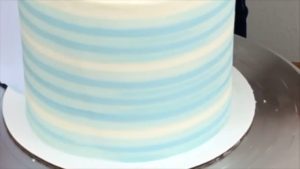
Because the indents are shallow and the grooves from my cake comb were deep, as I keep smoothing with my frosting scraper I’m taking off the outer layer of frosting and going deeper than the indents so eventually, those lines go away.

I love this striped cake comb technique and I’ll probably never go back to any other way of doing stripes but if you don’t have a cake comb, you can use piping bags to pipe rows of coloured frosting onto your cake. Alternate colours and make sure there are no gaps in between the rows of piped frosting.
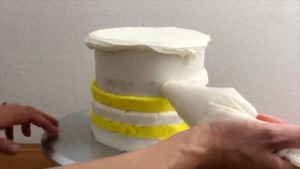
Then use your frosting scraper to smooth the frosting, touching up any areas where there are air pockets by spreading more buttercream over them.
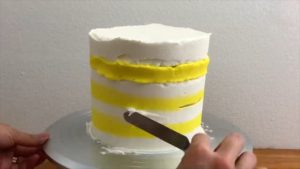
Smooth the sides and the top until you’re happy with the stripes!

This method is quick and easy and makes less perfect but more rustic-looking stripes.

I can’t wait to see the different stripes that you create! Please tag me @britishgirlbakes if you share a photo of your striped creation on instagram!
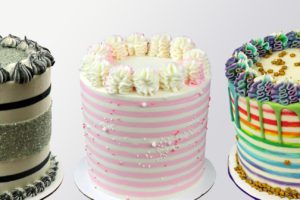
Here’s the video version of this tutorial:
